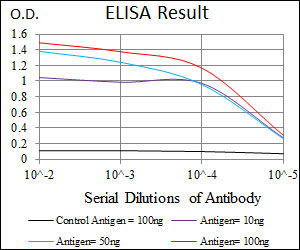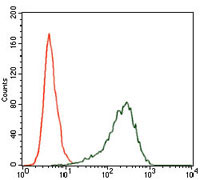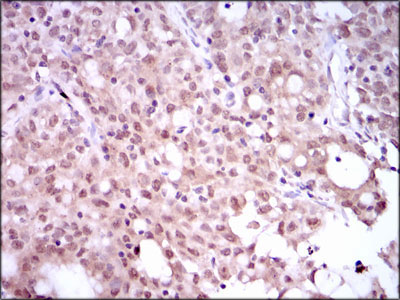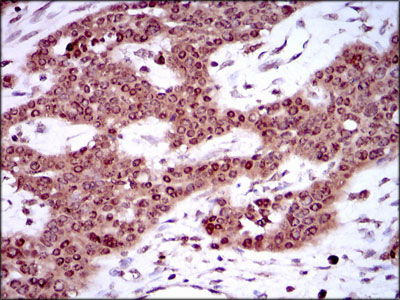SRY Antibody
Purified Mouse Monoclonal Antibody
- SPECIFICATION
- CITATIONS
- PROTOCOLS
- BACKGROUND

Application
| WB, IHC, FC, E |
|---|---|
| Primary Accession | Q05066 |
| Reactivity | Human |
| Host | Mouse |
| Clonality | Monoclonal |
| Clone Names | 1G4 |
| Isotype | IgG1 |
| Calculated MW | 23.9kDa |
| Description | This intronless gene encodes a transcription factor that is a member of the high mobility group (HMG)-box family of DNA-binding proteins. This protein is the testis-determining factor (TDF), which initiates male sex determination. Mutations in this gene give rise to XY females with gonadal dysgenesis (Swyer syndrome); translocation of part of the Y chromosome containing this gene to the X chromosome causes XX male syndrome. |
| Immunogen | Purified recombinant fragment of human SRY (AA:1-204) expressed in E. Coli. |
| Formulation | Purified antibody in PBS with 0.05% sodium azide |
| Gene ID | 6736 |
|---|---|
| Other Names | Sex-determining region Y protein, Testis-determining factor, SRY, TDF |
| Dilution | WB~~1/500 - 1/2000 IHC~~1/200 - 1/1000 FC~~1/200 - 1/400 E~~1/10000 |
| Storage | Maintain refrigerated at 2-8°C for up to 6 months. For long term storage store at -20°C in small aliquots to prevent freeze-thaw cycles. |
| Precautions | SRY Antibody is for research use only and not for use in diagnostic or therapeutic procedures. |
| Name | SRY {ECO:0000303|PubMed:1695712, ECO:0000312|HGNC:HGNC:11311} |
|---|---|
| Function | Transcriptional regulator that controls a genetic switch in male development (PubMed:11563911). It is necessary and sufficient for initiating male sex determination by directing the development of supporting cell precursors (pre-Sertoli cells) as Sertoli rather than granulosa cells (PubMed:16414182, PubMed:16996051). Involved in different aspects of gene regulation including promoter activation or repression (PubMed:9525897). Binds to the DNA consensus sequence 5'- [AT]AACAA[AT]-3' (PubMed:11563911, PubMed:1425584, PubMed:15170344, PubMed:8159753, PubMed:8265659). SRY HMG box recognizes DNA by partial intercalation in the minor groove and promotes DNA bending (PubMed:11563911, PubMed:1425584, PubMed:15170344, PubMed:16762365, PubMed:8159753, PubMed:8265659). Also involved in pre-mRNA splicing (PubMed:11818535). In male adult brain involved in the maintenance of motor functions of dopaminergic neurons (By similarity). |
| Cellular Location | Nucleus speckle. Cytoplasm Nucleus. Note=Acetylation contributes to its nuclear localization and deacetylation by HDAC3 induces a cytoplasmic delocalization (PubMed:15297880). Colocalizes with SOX6 in speckles (PubMed:11818535). Colocalizes with CAML in the nucleus (PubMed:15746192). Colocalizes in the nucleus with ZNF208 isoform KRAB- O and tyrosine hydroxylase (TH) (By similarity). Nuclear import is facilitated by XPO4, a protein that usually acts as a nuclear export signal receptor (PubMed:19349578). {ECO:0000250|UniProtKB:Q05738, ECO:0000269|PubMed:11818535, ECO:0000269|PubMed:15297880, ECO:0000269|PubMed:15746192, ECO:0000269|PubMed:19349578} |

Thousands of laboratories across the world have published research that depended on the performance of antibodies from Abcepta to advance their research. Check out links to articles that cite our products in major peer-reviewed journals, organized by research category.
info@abcepta.com, and receive a free "I Love Antibodies" mug.
Provided below are standard protocols that you may find useful for product applications.
References
1.J Biol Chem. 2009 Dec 18;284(51):35670-80.2.FASEB J. 2009 Nov;23(11):4029-38.
If you have used an Abcepta product and would like to share how it has performed, please click on the "Submit Review" button and provide the requested information. Our staff will examine and post your review and contact you if needed.
If you have any additional inquiries please email technical services at tech@abcepta.com.













 Foundational characteristics of cancer include proliferation, angiogenesis, migration, evasion of apoptosis, and cellular immortality. Find key markers for these cellular processes and antibodies to detect them.
Foundational characteristics of cancer include proliferation, angiogenesis, migration, evasion of apoptosis, and cellular immortality. Find key markers for these cellular processes and antibodies to detect them. The SUMOplot™ Analysis Program predicts and scores sumoylation sites in your protein. SUMOylation is a post-translational modification involved in various cellular processes, such as nuclear-cytosolic transport, transcriptional regulation, apoptosis, protein stability, response to stress, and progression through the cell cycle.
The SUMOplot™ Analysis Program predicts and scores sumoylation sites in your protein. SUMOylation is a post-translational modification involved in various cellular processes, such as nuclear-cytosolic transport, transcriptional regulation, apoptosis, protein stability, response to stress, and progression through the cell cycle. The Autophagy Receptor Motif Plotter predicts and scores autophagy receptor binding sites in your protein. Identifying proteins connected to this pathway is critical to understanding the role of autophagy in physiological as well as pathological processes such as development, differentiation, neurodegenerative diseases, stress, infection, and cancer.
The Autophagy Receptor Motif Plotter predicts and scores autophagy receptor binding sites in your protein. Identifying proteins connected to this pathway is critical to understanding the role of autophagy in physiological as well as pathological processes such as development, differentiation, neurodegenerative diseases, stress, infection, and cancer.







